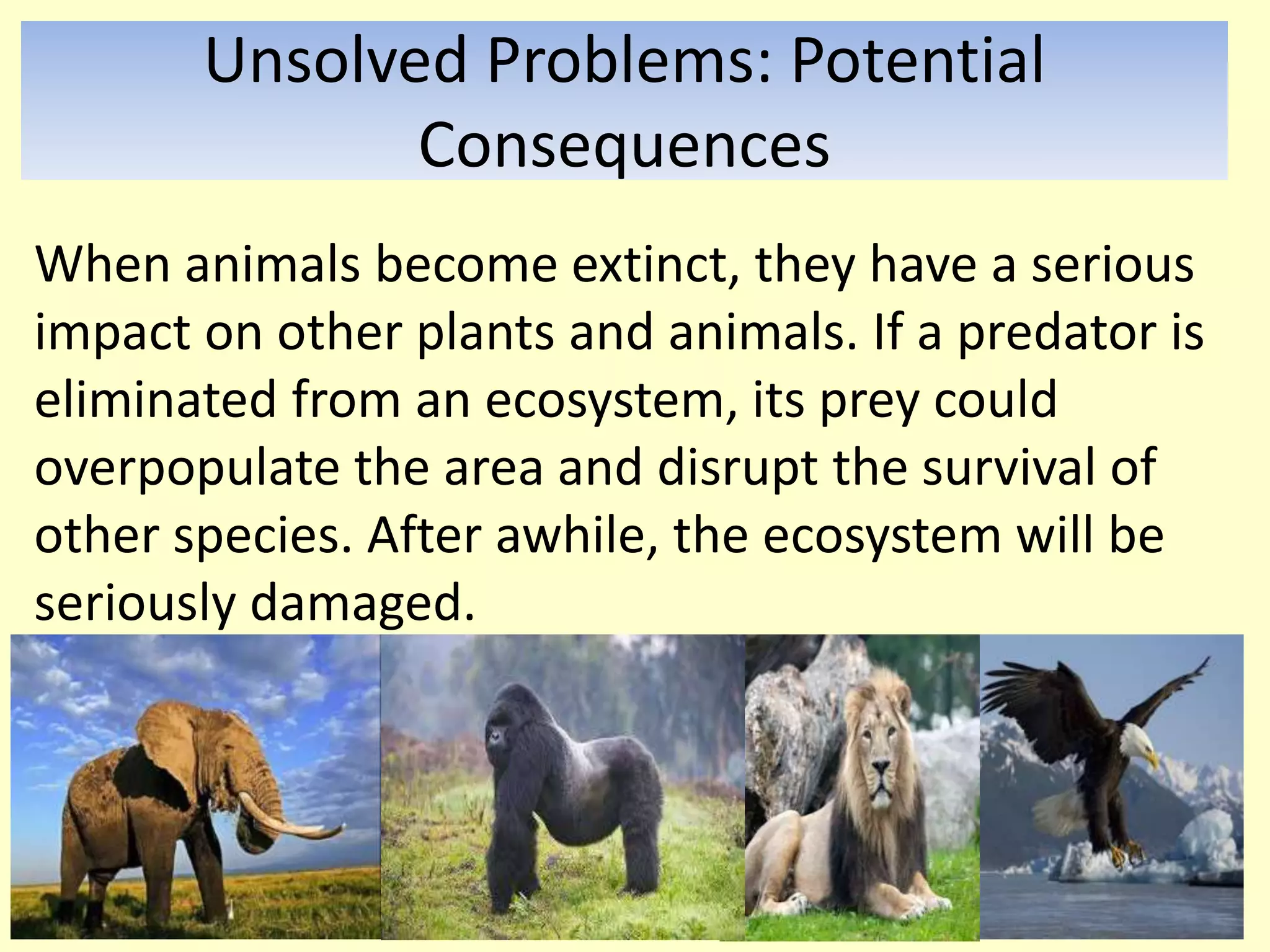The Wonder Of Animals: Threats And Solutions For Endangered Species

Table of Contents
Habitat Loss and Degradation: A Primary Threat to Endangered Species
The destruction and fragmentation of natural habitats are arguably the most significant threats to endangered species. Human activities are the primary drivers of this crisis, impacting countless animals worldwide.
Deforestation and Urban Sprawl:
The relentless expansion of human settlements and agriculture leads to habitat fragmentation and destruction, leaving many animals with nowhere to live. This process, often fueled by unsustainable logging practices and rapid urbanization, shrinks the available space for wildlife, forcing them into smaller, isolated pockets. The consequences are dire:
- Loss of nesting sites for birds: Many bird species rely on specific tree types or habitats for nesting. Deforestation eliminates these crucial resources, leading to reproductive failure and population declines. Examples include the critically endangered Philippine eagle and the Kirtland's warbler.
- Reduced foraging areas for mammals: Mammals require large territories to find sufficient food and shelter. Habitat fragmentation restricts their access to resources, resulting in malnutrition, increased competition, and ultimately, population crashes. Think of the impact on large carnivores like tigers and lions.
- Disruption of migration patterns: Many animals undertake long migrations to find food or breeding grounds. Habitat loss and fragmentation interrupt these essential journeys, leading to starvation, breeding failure, and reduced genetic diversity. Monarch butterflies and wildebeest are prime examples.
- Increased human-wildlife conflict: As human settlements encroach upon wildlife habitats, encounters between humans and animals become more frequent. This can lead to injuries, property damage, and retaliatory killings, further endangering already vulnerable species.
Climate Change and its Impact:
Climate change is exacerbating habitat loss and degradation, creating additional challenges for endangered species. Shifting climate patterns are altering habitats, making them unsuitable for many species. This includes:
- Coral bleaching impacting marine life: Rising ocean temperatures cause coral bleaching, leading to widespread coral death and devastating the biodiversity of coral reef ecosystems. Countless fish and invertebrate species depend on these habitats.
- Changes in plant life affecting herbivores: Changes in temperature and precipitation patterns alter plant communities, affecting the food sources for herbivores. This can lead to population declines among herbivores and subsequently their predators.
- Increased competition for resources: As habitats shrink and resources become scarcer due to climate change, competition between species intensifies, further threatening already vulnerable populations.
- Range shifts forcing species into unsuitable environments: Species are forced to shift their ranges in response to changing climates, but suitable habitats may not always be available or accessible. This can lead to range contractions and population decline.
Poaching and Illegal Wildlife Trade: A Grave Danger for Endangered Animals
The illegal wildlife trade is a significant threat to numerous endangered species, driving many towards extinction. The demand for wildlife products fuels poaching, creating a devastating cycle of exploitation.
The Demand for Wildlife Products:
The high prices offered for illegal wildlife products, such as ivory, rhino horn, and pangolin scales, drive the illegal trade. This demand is fueled by:
- High prices offered for illegal products: The perceived medicinal or status value of certain animal parts drives exceptionally high prices on the black market, making poaching a lucrative business.
- Lack of law enforcement in certain areas: Weak law enforcement and corruption in some regions facilitate the illegal trade, enabling poachers to operate with relative impunity.
- Corruption facilitating the illegal trade: Bribery and other forms of corruption within law enforcement and government agencies undermine efforts to combat poaching and trafficking.
- Demand driven by traditional medicine and luxury goods: The demand for wildlife products is driven by various factors, including the use of animal parts in traditional medicine and the creation of luxury goods from ivory, fur, and other materials.
Protecting Vulnerable Species from Poachers:
Combating poaching requires a multi-faceted approach:
- Anti-poaching patrols and technology: Increased patrols, supported by advanced surveillance technology such as drones and GPS tracking, can help to deter poachers and improve enforcement.
- Community-based conservation programs: Involving local communities in conservation efforts can empower them to protect their natural resources and provide alternative livelihoods to reduce reliance on poaching.
- International collaboration to combat illegal trade: International cooperation is crucial to disrupt the networks that facilitate the illegal trade in wildlife products.
- Educating consumers about the ethical implications of purchasing wildlife products: Raising public awareness about the devastating impact of the illegal wildlife trade can help reduce demand for these products.
Invasive Species: Disrupting the Ecosystem Balance
Invasive species, introduced outside their native range, pose a significant threat to many endangered species. These non-native organisms can dramatically alter ecosystems, causing widespread damage.
Competition and Predation:
Invasive species can disrupt the delicate balance of ecosystems through:
- Introduction of non-native predators: Invasive predators can decimate native populations, particularly those without natural defenses against the new threat.
- Competition for food and shelter: Invasive species can outcompete native animals for essential resources, leading to population declines and even extinctions.
- Introduction of diseases: Invasive species can introduce novel diseases to which native species lack immunity, leading to widespread mortality.
- Alteration of habitats: Invasive species can alter habitats in ways that make them unsuitable for native animals, further contributing to population declines.
Management and Control Strategies:
Effective management of invasive species requires a proactive approach:
- Strict border controls to prevent the introduction of invasive species: Rigorous border inspections and quarantine measures can help to prevent the introduction of new invasive species.
- Monitoring programs to detect new invasions: Early detection of invasive species is crucial for effective management. Regular monitoring programs can help identify and respond to new invasions quickly.
- Development and implementation of control strategies tailored to specific invasive species: Control strategies can include biological control, physical removal, or chemical treatments. The most appropriate strategy depends on the specific invasive species and the ecosystem it affects.
- Public education to increase awareness of the problem: Public awareness campaigns can educate people about the risks of invasive species and encourage them to take action to prevent their spread.
Effective Conservation Strategies to Protect Endangered Species
Protecting endangered species requires a multifaceted approach combining various conservation strategies.
Habitat Protection and Restoration:
Protecting and restoring habitats is fundamental to the survival of many endangered species:
- Creation of national parks and wildlife reserves: Establishing protected areas safeguards crucial habitats from development and other destructive activities.
- Habitat restoration projects: Restoring degraded habitats can create suitable environments for endangered species to thrive.
- Development of wildlife corridors to connect fragmented habitats: Connecting fragmented habitats through wildlife corridors allows animals to move freely between areas, increasing genetic diversity and resilience.
Captive Breeding and Reintroduction Programs:
Captive breeding programs and reintroduction efforts play a vital role:
- Breeding programs in zoos and other facilities: Captive breeding programs can help increase the population of critically endangered species before reintroducing them into the wild.
- Reintroduction programs with careful monitoring and support: Reintroduction programs require careful planning and monitoring to ensure the success of reintroduced populations.
Community-Based Conservation:
Engaging local communities is essential for long-term conservation success:
- Empowering local communities to manage and protect their natural resources: Providing communities with the tools and resources to manage and protect their natural resources fosters a sense of ownership and responsibility.
- Providing economic incentives for conservation: Providing alternative income sources can reduce reliance on activities that harm wildlife and their habitats.
- Educating communities about the importance of biodiversity: Education and awareness campaigns can foster a sense of responsibility and encourage participation in conservation efforts.
Conclusion
The wonder of animals is under threat. The escalating crisis of endangered species demands urgent and concerted action. By understanding the complex threats—habitat loss, poaching, invasive species—and by actively implementing effective conservation strategies—habitat protection, captive breeding, community engagement—we can significantly improve the chances of survival for countless endangered species. Let's work together to protect these incredible creatures and ensure that future generations can also experience the wonder of animals. Join the fight to save endangered species today! Learn more and find ways to support endangered species conservation efforts near you.

Featured Posts
-
 Napadi Na Rome Uni A Roma Srbi E Trazhi Zashtitu Od Marinike Tepi
May 13, 2025
Napadi Na Rome Uni A Roma Srbi E Trazhi Zashtitu Od Marinike Tepi
May 13, 2025 -
 Nba Draft Lottery Rules Explained A Comprehensive Guide
May 13, 2025
Nba Draft Lottery Rules Explained A Comprehensive Guide
May 13, 2025 -
 Pryachetsya Za Mat Skandal Vokrug Alimentov Syna Kadyshevoy
May 13, 2025
Pryachetsya Za Mat Skandal Vokrug Alimentov Syna Kadyshevoy
May 13, 2025 -
 Ghaziabad Issues Advisory For Outdoor Workers Noida News
May 13, 2025
Ghaziabad Issues Advisory For Outdoor Workers Noida News
May 13, 2025 -
 Salman Khans Box Office Performance A 4 7 Budget Return
May 13, 2025
Salman Khans Box Office Performance A 4 7 Budget Return
May 13, 2025
Latest Posts
-
 Electric Vehicle Market Shift Byds Global Expansion And Fords Brazilian Legacy
May 13, 2025
Electric Vehicle Market Shift Byds Global Expansion And Fords Brazilian Legacy
May 13, 2025 -
 Fords Retreat Byds Advance Analyzing The Shifting Landscape Of The Brazilian Auto Market
May 13, 2025
Fords Retreat Byds Advance Analyzing The Shifting Landscape Of The Brazilian Auto Market
May 13, 2025 -
 Onko Trumpin Politiikka Auttanut Byd Tae Ohittamaan Teslan
May 13, 2025
Onko Trumpin Politiikka Auttanut Byd Tae Ohittamaan Teslan
May 13, 2025 -
 Chinas Byd Targets Brazil As Fords Influence Wanes A New Era In Ev Sales
May 13, 2025
Chinas Byd Targets Brazil As Fords Influence Wanes A New Era In Ev Sales
May 13, 2025 -
 Byd Vs Tesla Trumpin Paeaetoeksen Seuraukset
May 13, 2025
Byd Vs Tesla Trumpin Paeaetoeksen Seuraukset
May 13, 2025
